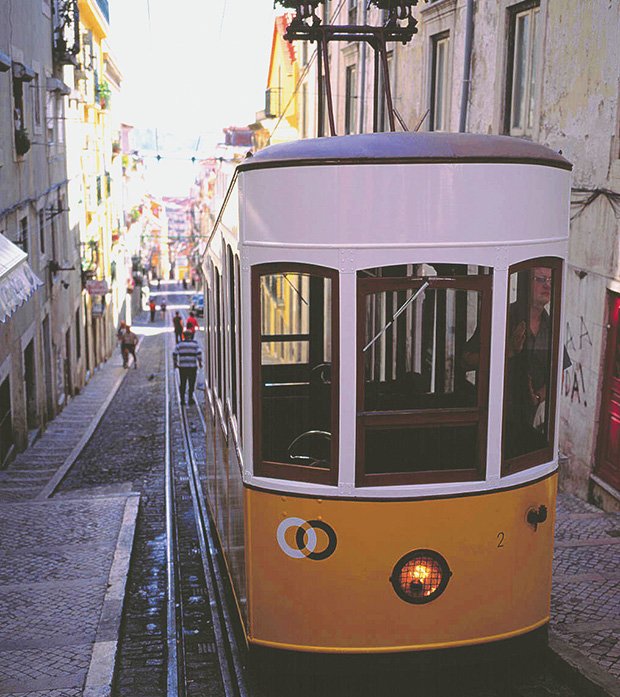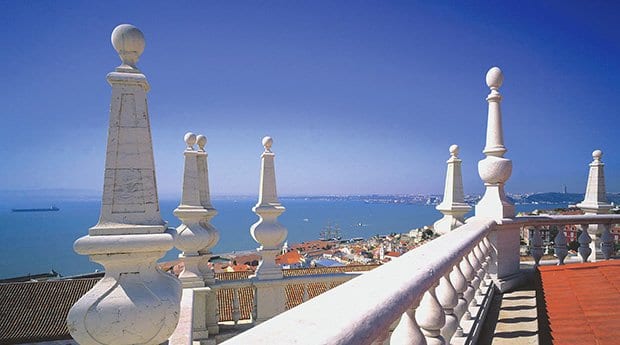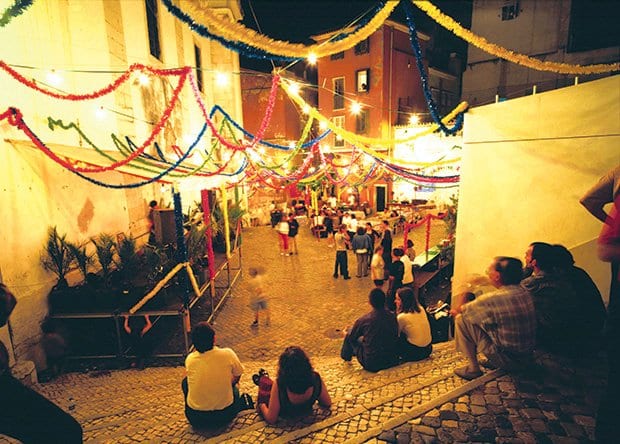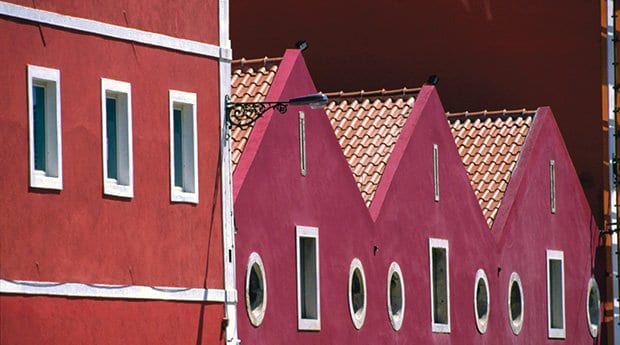
The Glória funicular links Baixa with Bairro Alto. Credit: Jose Manuel

The renaissance-style St Vicente de Fora church houses a number of royal tombs. Credit: Jose Manuel

Small street celebrations are a common sight in Lisbon. Credit: Jose Manuel
Portugal’s capital city of Lisbon (Lisboa in Portuguese), situated at the mouth of the Tagus River on the Atlantic coast, is Europe’s second-oldest urban centre. An important city in Europe’s Age of Discovery, it was the departure point of the great explorers Vasco da Gama, Ferdinand Magellan and Prince Henry the Navigator.
The city is an intriguing combination of two contrasting and unique architectural styles: the 16th-century Manueline, of the Belem district, and the 18th-century Pombaline, of downtown. The Belem district, on the north bank of the Tagus River, is home to a trio of must-see landmarks: the Belém Tower, one of the city’s most photographed sites; the Jéronimos Monastery, which, along with the Belém Tower, is a UNESCO World Heritage site; and the Monument to the Discoveries, which marks the point from which the famous explorers set off on their voyages.
The backdrop of Lisbon consists of the gorgeous palaces and old churches typical of any great historical capital, with contemporary architecture giving the city a touch of modernization. Its back streets and narrow passageways have long been one of the city’s most charming characteristics; a simple and satisfying pleasure is to wander and take in the streetlife and atmosphere of the old quarters.
On June 5, 2010, Portugal became the eighth country in the world to recognize same-sex marriage, and its people have embraced a new era of equality and inclusiveness. The districts of Bairro Alto, Chiado and Principe Real all have thriving gay scenes.
Bairro Alto is a picturesque 16th-century-accented district that has traditionally been the city’s bohemian quarter and is a popular hangout for artists and writers. By day it’s quite calm; at night it’s transformed by its vibrant nightlife. With its graffiti-clad façades, the area offers a variety of excellent traditional and international restaurants, fado houses, upscale bars and designer shops that stay open late.
Next to Bairro Alto is Chiado, a posh district that delights the senses with old-style cafés, theatres, boutiques, jewellery shops and brand-name boutiques such as Cartier and Hermès. Ranked among the top 10 international metropolitan districts, it’s often compared to Fifth Ave in New York, Oxford St in London, and the Champs-Élysées in Paris.
Principe Real is known for its antique and interior design shops on Rua Dom Pedro V and Rua da Escola Politécnica, and also for being the city’s main gay quarter, with numerous bars and clubs. Every year more gay establishments open in this area, offering both locals and foreigners a place of welcome and acceptance. As in many European capitals, the nightlife starts very late and can last until sunrise.
Fado houses — an absolute must-visit during your stay in Lisbon — can be found throughout the city, especially in the Bairro Alto, where local artists sing to a style of music that dates back to the 1800s. The word fado translates as “fate,” and the beautiful lyrics tell of sorrow and destiny. This style of singing can be heard only in Portugal and is a sound as authentic as the locals.
Lisbon has some of the largest shopping malls in Europe. The most central is Armazéns do Chiado; the largest is Colombo. If you’re looking for more traditional markets, head to the downtown Mercado da Ribeira or the flea market of Feira da Ladra in Alfama. Avenida da Liberdade is Lisbon’s main boulevard; it runs north for a mile, from Restauradores Square to Marquês de Pombal Square, and is home to a plethora of boutiques, cafés, luxury hotels and designer shops. It’s also where you’ll find the Monument to the Heroes of the Great War, a tribute to the 50,000 Portuguese soldiers who died in World War I.
Lisbon is a city best explored on foot, but there is an efficient public transit network. The GoLisbon website has good transportation info. More unusual modes of transportation include funiculars that take you directly uphill, and an elevator designed by Gustave Eiffel (he of the famous tower in Paris). Carris is the transportation company that runs buses, trams and funiculars. The most convenient and affordable mode of transportation is the Metro, which runs daily from 6am until 1am. Beige-coloured taxis are available throughout the city and rates are very reasonable.
There are five railway stations; check the Comboios Portugal website for info. The main departure point for international destinations is Santa Apolónia Station, located on Avenida Infante. Along the railway line that links Lisbon to Cascais are several broad beaches that attract locals and tourists, including Guincho, known worldwide for its surfing. All are within 20 to 30 minutes of the capital. There are two main gay beaches: Costa da Caparica and Beach 19 (also known as Praia de Bela Vista).
Portuguese cooking is heavily influenced by the Atlantic Ocean, and fish and seafood are staples. Be sure to try arroz de marisco, a rice and shellfish dish, and the many different styles of fish stew. As for meat, there is one true national speciality: the renowned cozido à Portuguesa blends meat and vegetables into a richly flavoured stew. Pastel de nata, an egg custard tart served with a sprinkle of cinnamon, is best enjoyed with a strong cup of espresso.
Bars & Clubs
Clube da Esquina
Portas Largas
Lodgings
Hotel Métropole
Pensão Residencial Gerês
Restaurants & Cafés
Les Mauvais Garçons
Tavares Rico
Saunas & Sex Clubs
SaunApolo 56
Trombeta Bath

 Why you can trust Xtra
Why you can trust Xtra